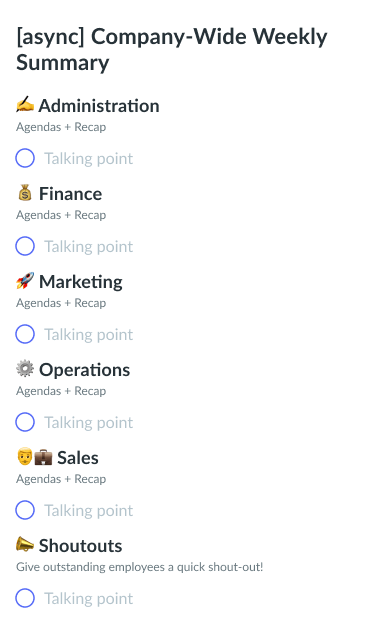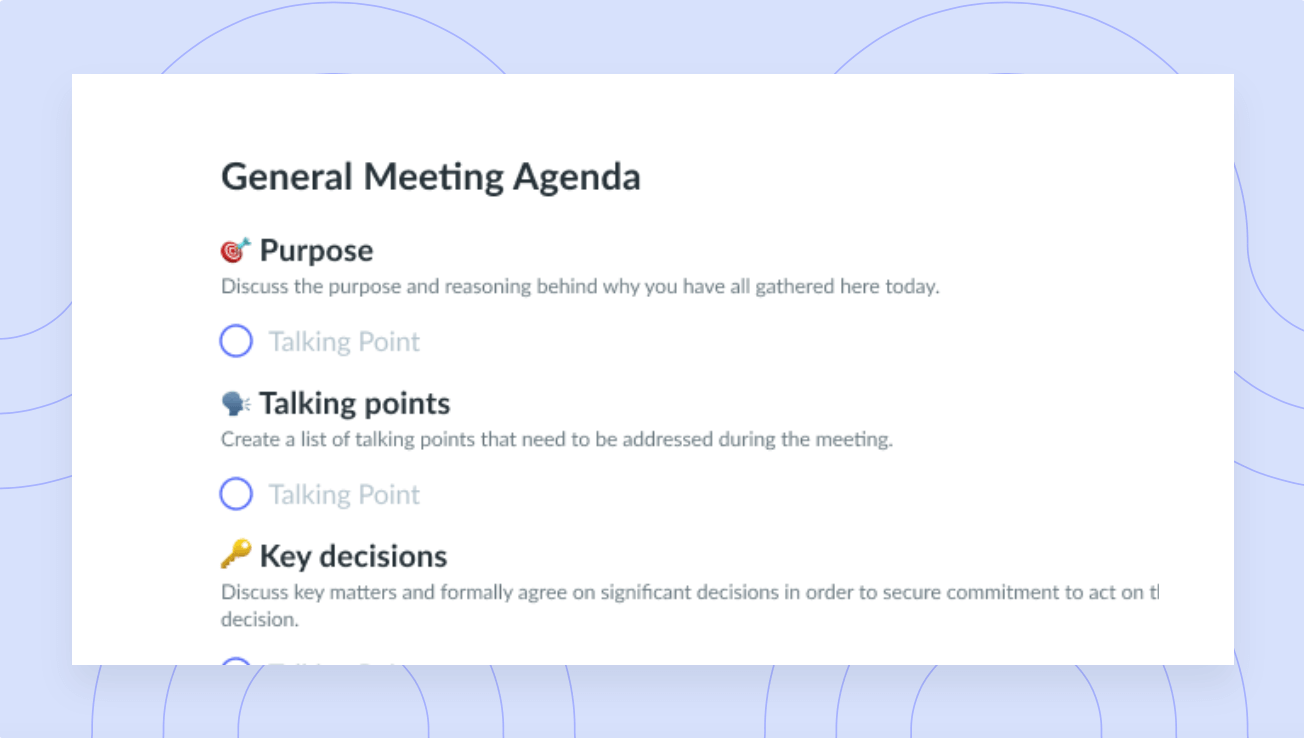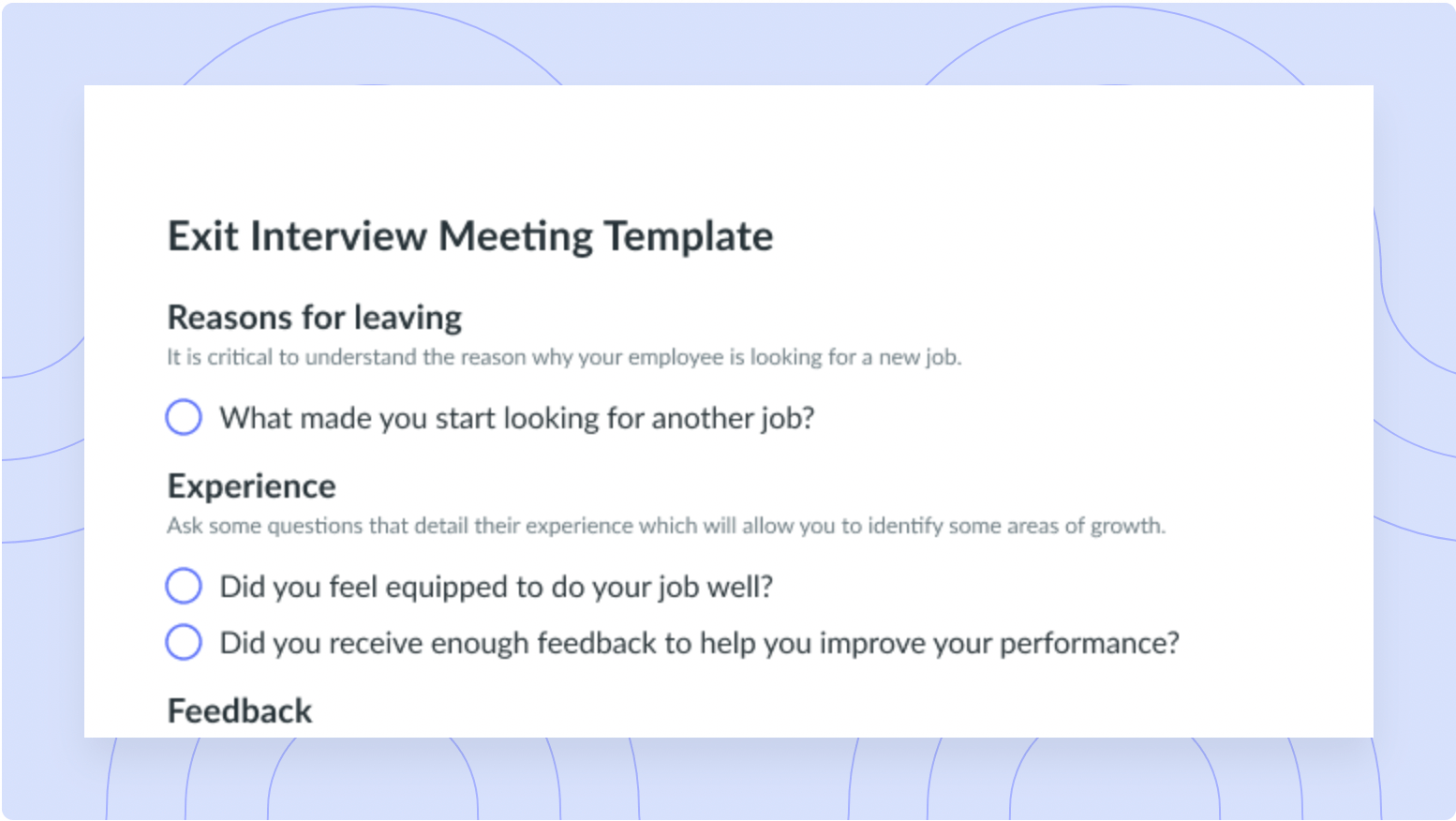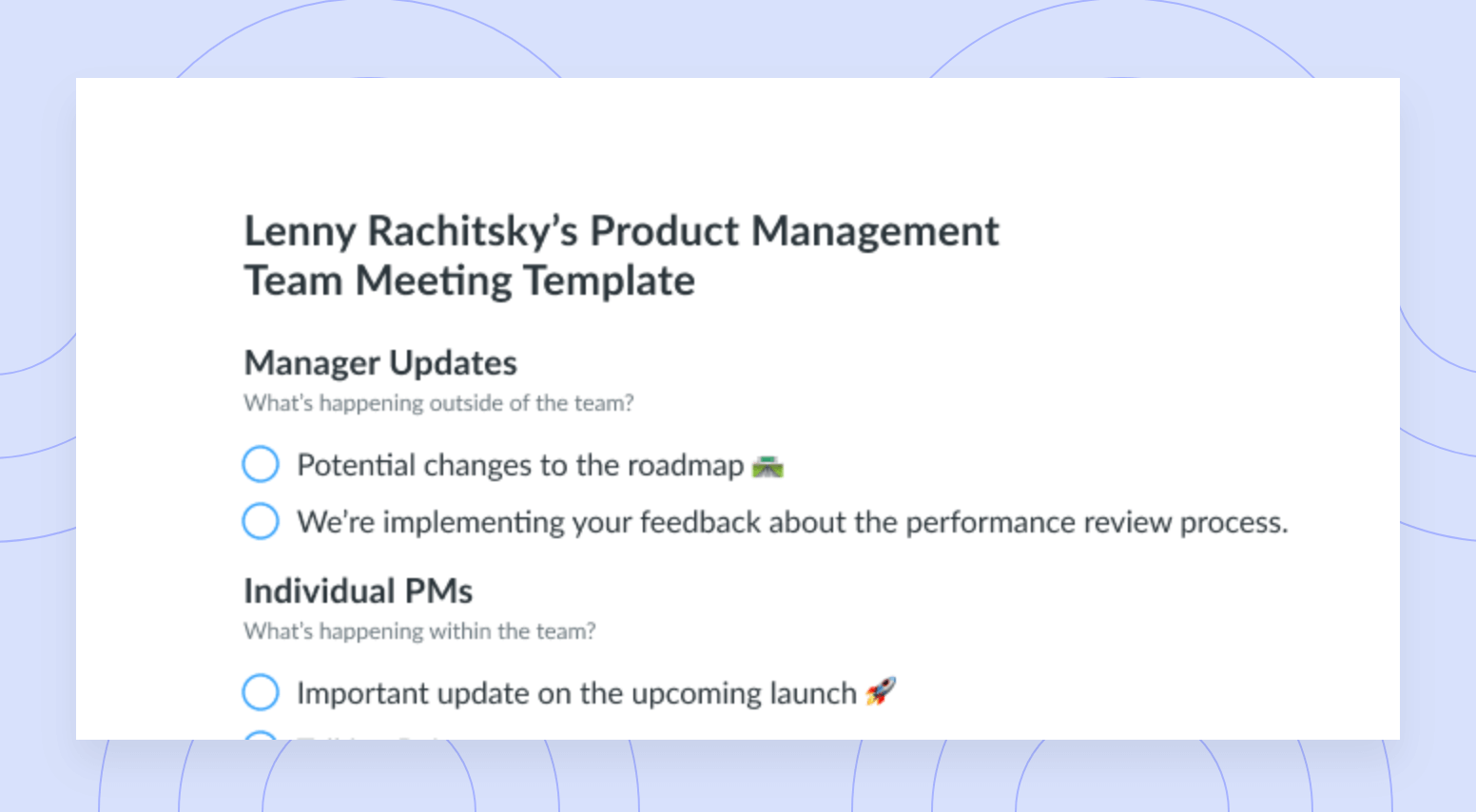Asynchronous Work: 7 Tips for Your Team [+ Free Template]
Discover the power of asynchronous work and learn practical strategies to boost your team's productivity and enhance collaboration.
Some of the world’s greatest teams are opting into asynchronous work in 2023. Whether a group of employees is working remotely, has a hybrid setup, or is distributed across time zones, there are undeniable benefits to providing the kind of flexibility asynchronous work offers.
Read on to learn about asynchronous work, see how it differs from synchronous work, explore the benefits of asynchronous work environments, and view how you can level up your own asynchronous work practices with Fellow.
- What is asynchronous work?
- Asynchronous work vs. synchronous work
- Benefits of asynchronous work
- 7 tips for improving your team’s asynchronous work
- When to implement asynchronous vs. synchronous work
- Free asynchronous meeting agenda template
What is asynchronous work?
Asynchronous work involves working on a team that doesn’t rely on real-time interactions by phone, video, or in person. Asynchronous teams leverage the power of asynchronous communication, meaning that employees may discuss tasks and projects over email, messaging apps, or through project management software.
“Asynchrony is ideal for distributed teams, especially those working globally. If you’ve ever been awakened by a 3 a.m. text ping from a colleague on the other side of the world and felt the immediate urge to respond, you know what I’m talking about.”
— Victor Val Mas, Forbes Brand Contributor
Asynchronous work vs. synchronous work
Asynchronous work
In asynchronous work, communication is not expected to be immediate. Companies with asynchronous teams place trust in their employees to deliver results and have processes that utilize robust digital infrastructure. Leaders of asynchronous work environments place trust in their employees, often leading to massive benefits and enhanced productivity. Some examples of communication in an asynchronous workplace include emails, messaging applications, project management systems, and cloud-based document-sharing platforms.

Run effective asynchronous meetings
Increase asynchronous meeting engagement and productivity with a collaborative agenda that the whole team can contribute to. Try using a tool like Fellow!
Synchronous work
In a synchronous work environment, in-person and remote employees work together at the same time. All members of a team are in the office or online together and make themselves available to their colleagues throughout the workday. Synchronous work usually consists of in-person meetings, phone calls, messaging apps like Slack, and video calls on apps like Zoom or Microsoft Teams. Working synchronously may slow down projects by placing artificial barriers to productivity.
“If it [a meeting] is contentious – if you’re talking about problems and there might be different opinions – maybe that deserves to be synchronous, but otherwise, it can be asynchronous.”
— Cate Huston, Engineering Director of Mobile at DuckDuckGo
Benefits of asynchronous work
- Offers flexibility
- Accommodates different work styles
- Increases productivity and focus time
- Fosters collaboration
- Reduces meeting fatigue
1Offers flexibility
Asynchronous work allows employees to work from anywhere at a time most convenient to them. In asynchronous work environments, individuals can complete tasks and projects while tending to personal responsibilities and without dependence on their teammates’ availability. Asynchronous work also means that companies can hire talent across time zones!
2Accommodates different work styles
Every employee has a unique working style. In asynchronous work environments, introverted employees who would rather not contribute to big group sessions during in-person meetings can shine. Asynchronous work doesn’t require employees to be fast thinkers, allowing for slower, thoughtful contributions to strategies and projects as well.
3Increases productivity and focus time
Asynchronous workers aren’t expected to respond to colleagues at all times, so they can more easily block out time during their day for time-consuming projects that require maximum focus. Employees in asynchronous work environments can often achieve deep concentration because of the few interruptions they encounter during their workdays.
4Fosters collaboration
Asynchronous work environments let people work on specific tasks when they feel most productive. It also allows employees to collaborate when they feel most productive because there aren’t strict meeting times or parameters. Employees can use asynchronous channels like messaging apps or video walk-throughs to supplement in-person conversations and build rapport with teammates.
5Reduces meeting fatigue
Meeting fatigue is a feeling of mental and physical tiredness that occurs when employees are subjected to too many real-time group sessions and one-on-ones. Because employees are online at different times in asynchronous work environments, asynchronous work can minimize meeting fatigue and, in turn, boost employee engagement and morale.
7 tips for improving your team’s asynchronous work
- Use asynchronous work software
- Establish communication guidelines
- Avoid time-zone bias
- Get buy-in from leadership executives
- Communicate your work preferences
- Avoid using email as your main communication channel
- Clear messages regularly
1Use asynchronous work software
There are plenty of digital tools on the market that can help you optimize your team’s asynchronous work habits. For instance, with Fellow, your team can run recurring asynchronous meetings using automation and other streams. Meeting organizers can also create recurring calendar events, select a template for their stream, and have meeting attendees easily add in their points. Once everyone has added their notes, indicated individuals will be sent notes. Check out this review from one of our users:
“We’ve discovered the beauty of having asynchronous meetings, and Fellow helps us accomplish this. We can create templates with deadlines to have them filled out and have been able to reclaim some of our meeting time back! It has been very crucial for us to be able to work across global teams. Just this morning we moved one of the meetings that span across multiple timezones into an asynchronous format to keep ourselves organized and held accountably.”
— Verified User in Computer Software, G2
2Establish communication guidelines
Setting clear expectations for communication is important for asynchronous teams to be successful. Managers of asynchronous teams should develop an internal communication plan that outlines how often and where employees are expected to communicate with one another. For example, company leaders can ask that employees reply to Slack messages within 24 hours as a best practice or create clear instructions on how important information should trickle down from management without issue.
3Avoid time-zone bias
For asynchronous work to go well, leaders shouldn’t favor specific time zones. If an organization has employees around the world, time-zone bias can signal to employees that asynchronous workflows aren’t a priority. Managers can eliminate bias by offering deadlines that align with employees’ specific working hours, recording real-time sessions to share with teammates who are unable to attend, and offering several instances for individuals around the globe to attend meetings that suit their schedules.
4Get buy-in from leadership executives
Company leaders must buy into the idea that implementing an asynchronous workflow is worthy of the changes that come with it. While most executives feel comfortable with in-person, hybrid, and remote work, asynchronous work practices may feel foreign. Be as transparent as possible to avoid resistance from leadership. Clearly communicate the benefits of asynchronous work and what this change may involve so that leaders recognize the details, implications, and challenges that your team could face and are prepared to buy in.
5Communicate your work preferences
In an asynchronous work environment, employees must clearly communicate their work preferences to colleagues and management. Let your teammates know when you plan to be online so everyone knows when to expect replies to messages and emails or updates from you. For example, if Slack is your team’s messaging app of choice, you can regularly update your status or add a focus time that lets your colleagues know when you will be available and when you will be offline. When in doubt, overcommunicate!
6Avoid using email as your main communication channel
Many of us are guilty of using email as our sole communication channel. Use email to deliver long messages to colleagues and to prompt recipients to view web-based content or attachments, but use other communication such as messaging applications, project management software, and asynchronous meeting tools like Fellow to run asynchronous meetings, give quick updates, provide lengthy information or instructions, and move project pieces forward.
7Clear messages regularly
The key to asynchronous work is organization. Humans aren’t meant to have access to too many old communication materials, so don’t be afraid to delete what you no longer need. Reply to and clear your messages and emails regularly to keep your digital workspace clean. Set time aside on a weekly, monthly, or quarterly basis to complete a full digital declutter.
When to implement asynchronous vs. synchronous work
Here are a few examples of when it’s best to use asynchronous and synchronous work practices:
When to use asynchronous work practices:
- Status updates: Use asynchronous meetings or messaging apps to communicate about projects and exchange information throughout your workday.
- Focused work: An asynchronous work environment works well when individuals require intense focus time for detailed tasks and projects.
- Instructions and how-tos: Record sessions on topics like how to use software and instructions on how to follow company procedures to share with employees during the onboarding process or for those who need refreshers on other occasions.
When to prioritize synchronous work:
- One-on-one meetings: It’s best to host employee development conversations and feedback sessions in real-time. One-on-one meetings are a great opportunity to build and strengthen manager-employee relationships, so it’s important to prioritize them, even in asynchronous work environments.
- Difficult conversations and emergencies: Topics like underperformance, employee relations issues, bad news, or urgent and pressing concerns are best had in person or via video conferencing tools like Microsoft Teams, Google Meet, and Zoom.
Free asynchronous meeting agenda template
Your team can use Fellow to easily run asynchronous meetings that everyone will want to attend. Create a recurring calendar event, send invites to all participants, set a template for your stream, and add in your talking points. Once these steps are completed, add automations by clicking the lightning bolt icon to launch. Use pre-meeting reminders as well as our post-meeting recap feature and configure them to timelines that work best for you and your teammates.
Parting advice
Asynchronous work allows teams that work across multiple time zones to maximize precious working hours. The 2023 Remote Workforce Report shows that 44% of companies are increasing the number of full-time employees working remotely from another country. Remote work is here to stay, and with it comes asynchronous environments. If you want to level up your asynchronous work practices, try out our seven tips for improving your team’s work and watch as your team’s productivity skyrockets!






![How to Create a Team Agreement [+3 Examples]](https://fellow.app/wp-content/uploads/2023/05/team-agreement2.jpg)
























